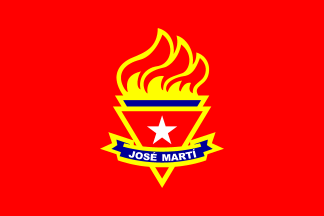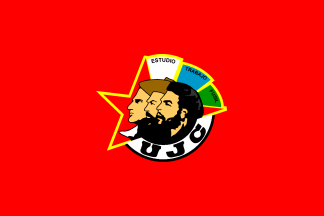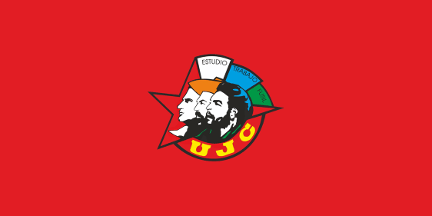![[Cuba 26 July Movement]](../images/c/cu-julio.gif)
image by Ivan Sache , 22 December 1999

Last modified: 2023-09-09 by rob raeside
Keywords: cuba | july 26 | communist party |
Links: FOTW homepage |
search |
disclaimer and copyright |
write us |
mirrors
See also:
![[Cuba 26 July Movement]](../images/c/cu-julio.gif)
image by Ivan Sache , 22 December 1999
![[Cuba 26 July Movement]](../images/c/cu}m267a.gif)
image by Maikel Arista-Salado and Eugene Ipavec,
2 August 2006
![[Cuba 26 July Movement]](../images/c/cu}m267b.gif)
image by Eugene Ipavec, 2 August 2006
![[Cuba 26 July Movement]](../images/c/cu}m267c.gif)
image by Eugene Ipavec, 28 August 2008
![[Cuba 26 July Movement]](../images/c/cu}m267d.gif)
image by Ivan Sache, 1 August 2010
In the center appears frequently a star (white or yellow) or
M26, 26-7, 26J, etc...
Jaume Ollé'
The flag of the 26 July Movement, as far as I can remember,
didn't spell 26 de Julio but M-26-7. Perhaps there is two
different versions.
Carlos M. Ramos , 7 Febuary 2000
The July 26th Movement flag appeared in several ways, two of
which were most prominent: one was the red above the black with a
white five point star in the centre, the other was the acronym
'M-26-7' in white letters in the middle, so that the top half
overlapped the red and the bottom the black. Alternately it could
appear with the '26 de Julio' in the middle or the phrase
"Libertad o Muerte" (Liberty or Death) in the middle in
white letters sometimes script, sometimes printed. I have seen
the originals of these versions in the Cuban revolutionary museum
in Havana (formerly Batista's palace).
Greg Dubecky, 18 February 2001
Eons ago, my parents' Caribbean cruise stopped in Havana. It
was shortly after Castro had seized power, and realtions with the
US had not been severed. They brought me back a souvenir flag/pin
which was red over black with a gold "26" on it.
Whether that had any official status or was just an abridged
version of a larger flag (to fit in a lapel) I don't know.
Al Kirsch, 19 February 2001 and 25 May 2002
The 26th of July Movement (Movimiento 26 de Julio) constituted
Fidel Castro's personal political following during the
anti-Batista period, founded 26 July 1956 (?), from which the
Communist Party was formed.
Source: Political Handbook of the World 1997
Jarig Bakker, 26 May 2002
Your source may not be reliable. My memory was that 26 July
was the anniversary of Castro's unsuccessful assault on the
Moncada Barracks. See <www.grossmont.net/mmckenzie/moncada.htm>.
The year was 1953. Cuba's Communist Party is much older than
that.
Al Kirsch, 26 May 2002
On 15 May 1947 Fidel Castro (while a student at the Univerity
of Havana) was a founding member of the Partido Del Pueblo Cubano
(later Partido Ortodoxo), devoted to political reform. In 1952 he
ran for Congress on this party ticket, but Batista cancelled the
elections in a bloodless coup. Castro consequently founded a
revolutionary movement which mounted its first attack (by 100
men) on the Batista regime on 26 July 1953 at Moncada Army
Barracks, Santiago. The attack was a dismal failure.
The few survivors were tried and imprisoned, but Castro's speech
in his defence was a propaganda coup as a call for revolution
("la historia me absolverá"). He was released on 15
May 1955 in a general amnesty. He and a few followers went
to Mexico on 24 June 1955, and in July 1955 organised the
Movimiento Revolucionario 26 de Julio (MR-26-7), named for their
first revolutionary act in 1953. On 30 November 1956, 300
men (led by Frank País) wearing red and black armbands with the
July 26 emblem (the first public display of this insignia?)
attacked police headquarters, the Customs House and the harbour
headquarters in Santiago. Two days later, 80 men led by
Castro in a leaky boat ("Granma") landed in Cuba to
resume to 1953 revolution. This too was a disaster, but 12
survivors fled to the Sierra Maestra and organised the first
guerrilla unit of the 26 July Movement on 18 December 1956.
Twenty-five months later the victorious movement entered Havana
and Batista fled. The former Batista Presidential Palace is
now the Museum of the Revolution and contains "Granma",
and countless artifacts and insignia and flags of the 26 July
Movement. To this day Castro wears a red/black lozenge of the 26
July Movement as his shoulder rank insignia for General of the
Army. (Other rank insignia are Russian-style shoulder
boards.)
During a few speeches in 1961, Castro began to refer to the
revolution as "socialist" and Marxist-Leninist.
On 3 October 1965 the new Communist Party was founded (originally
established in 1925). The First Congress of the Communist
Party met in 1975 and drafted a new constitution.
T.F. Mills, 30 May 2002
In Cuba there is a flag that's seen almost as the National
Flag but given scant attention as it doesn't enjoy the status and
rank of the national flag. I’m talking about the flag
of the 26 July Movement – the organization that deposed the
dictator Batista, and led by Fidel Castro (1953-1959).
The Movement adopted this name as it was on 26 July 1953 that the
struggle began to evict the tyrant from the Presidency. On that
day occurred the assault on regime strongholds of Moncada and
Carlos Manuel de Cispedes – the former the second most
important in the country. This historic event made Fidel a
household name in Cuba. From that point to the final
victory, the 26 July Movement become known the length and breadth
of the country, its emblem stuck on doors and windows as a sign
of approval. That custom stuck, and on anniversaries of the
Revolution, both flags are hoisted together.
The flag is used de facto, that is, it has no official
standing at law but is used informally as a sign of loyalty to
the Government and a signal of approval.
In many workplaces, offices and so on, it often appears together
with the national flag, in many cases of equal height and size
with the national flag, notwithstanding that it has no other
status than that of an historical curiosity that had its time and
place in the struggle against Batista.
To note is its similarity with the flag of the Sandinistas – although with
colours reversed.
Maikel Arista-Salado (translated by Tony Burton),
21 September 2004
Currently this flag is of official use, almost at the same
level as thre national flag. It is also shown on the site of the
Heralatin School of Cuba at <heralatin.t35.com>.
Maikel Arista-Salado (translated by Esteban Rivera),
3 June 2005
This movement's flag has a variant (with inscription "26
JULIO") seen in this commemoration act, shown on BBC
on July 26, 2008.
E.R., 26 August 2008
On "Radio Nuevitas", 26 July 2010, Ricardo Ferrer Aluija reports a 26 July
Movement flag of unusual design. THe flag is horizontally divided olive
green-black, with a red triangle charged with a white star placed along the
hoist, and the white writing "M - 26 - 7" over the two horizontal stripes.
This flag exists in several copies in the town of Nuevitas - located on the
nothern shore of Cuba, 70 km east of Camagüey. It was made in 1957 by Mercedes
Saroza Forcelledo upon request of his neighbour Ángel Gutiérrez Núñez. The
today's location of the prototype of the flag is unknown.http://www.radionuevitas.icrt.cu/index.php/noticias-nuevitas/2310-singular-bandera-del-26-de-julio.html
Ivan Sache, 1 August 2010

image by Eugene Ipavec, 14 February 2010
According to a stamp shown at <www.flagsonstamps.info>,
the flag of the Communist Party of Cuba should be plain red,
presumably in the same 1:2 ratio as the national flag.
Eugene Ipavec, 14 February 2010
At Ebay there were few Cuban Communist flags:
1) at <cgi.ebay.com/item=1076138959>
:
This flag was adquired in
Cuba a while ago. It is made of fabric, the letters are sew to
the flag and the center figure of Lazaro Pe-a (he was minister of
CTC (the Cuban Workers Union) back in the 70's.He died long time
ago.The faces around his portrait are all painted on the fabric
(interesting effect) ) and it says in espanish "And the seed
sprouts" on the other
side the embroided flag of the CTC is beautifully embroided
and still very bright. The flag measures 48"x30" and
except for a yellowish tone in some parts due to age, it is in
very good condition.
2) at <cgi.ebay.comitem=1076121595>
:
This flag was adquired in
Cuba a while ago. It is made of fabric, the letters are sew to
the flag and the center figure of Fidel Castro and Camilo
Cienfuegos is beautifully embroided and still very bright. The
flag measures 48"x30" and has some dirt but no rips.
Both sides have the same design. The curious part of this flag is
the historical significance. In 1970, the cuban government took
most workers to the cane fields because they projected the
largest sugarcane harvest in history (10 million tons of sugar)
They only got to 8.5 millions and the economy went down the
toilet because the rest of the industries were niglected. Every
time they reached to a new million of tons they would make these
flags and distributed to the best sugarcane cutters (a BRIGADE).
Now, this flag was prepared to give to the first BRIGADE to get
to the 9th million. BRIGADA NONA-MILLONARIA. So this flag never
had the use it was intented and probably the reason it survived
until today. The XVI anniversary is based on the July 26 of 1956
attack to Cuartel Moncada and the beginning of the Revolution.
3) at <gi.ebay.com/item=1076135114>
:
This flag was adquired in
Cuba a while ago. It is made of fabric, the letters are sew to
the flag and the center figure of Lazaro Pe-a (he was minister of
CTC (the Cuban Workers Union) back in the 70's. He died long time
ago) is beautifully embroided and still very bright. The flag
measures 48"x30" and except for a yellowish tone in
some parts due to age, it is in very good condition.
Rob Raeside, 21 Febuary 2002
Not sure if it was official but I have seen a pictures of
Cuban revolutionaries that used as a upper shoulder badge a flag
divided horizontaly red over black with a yellow star in the
middle.
Marc Pasquin, 6 March 2002
I recall a button in the shape of a flag which was red over
black with a yellow "26" (not a star). My parents
brought it back from Cuba not long after Castro took over. Is
this an alternative design to the one with the star, or is it
just a tourist souvenir?
Al Kirsch, 6 March 2002
That was probably the 26 July Movement flag
that was used by the revolutionaries. Initially, many of them
(including Castro) were not communist. The Communist party played
a large part in trying to get these guys to become communist in
the beginning, but failed until later.
Rob Raeside, 6 March 2002
Cuba has a rich flag heritage, and markedly so over the last
50 years. Society has become more flag conscious
(“vexilogizado”). Trade Unions all have their
flags, and so do other mass oragnziations, that in reality
function as political organizations properly so-called in these
sense that they are the means of mobilizing all or most of the
population. The greater number of these flags of “Mass
movements” have a red field, given the historic association
with the communists. I would personally be very interested to
know if the Soviets were the first to adopt that usage, or
whether there were historical antecedents.
Most of these flags have a red field with the organization emblem
in the centre – eg the National Pioneers organization and
those of Committees for the Defense of the Revolution (entities
for political repression but with a popular façade).
Maikel Arista-Salado (translated by Tony Burton),
21 September 2004

Organización de Pioneros "José Martí" (flag)
image by Eugene Ipavec, 14 February 2010
.gif)
Organización de Pioneros "José Martí" (logo)
image by Eugene Ipavec, 14 February 2010
One of the last remnants of the Pioneer organizations which
were to replace scouting in the Soviet system. Here is the flag of the José
Marti Pioneers' Association of Cuba.
Chrystian Kretowicz, 9 January 2002
Pioneers Organization "Jose Martí" - this
organization groups the primary and elementary education students
and those of high school, until 9th degree.
This one is the ordinary flag, the "protocolar" one
have a yellow fringe imitating silk, in all the edge, is used
preceded of Union de Jovenes Comunistas (UJC - Something like
Young Comunist Union) and the one of Communist Party of Cuba
(PCC), and all, naturally, of the National flag. It's, although
not officially, an organization with political intentions,
controlled by Young Communist Union. The initiation in
these organizations takes place with a traditional act which
consist of giving, depending the student's category, a
neckerchief, blue or red, that ties to the neck and since
that moment it form a part of the scholastic uniform.
It's very exciting. I made it twice, first when I received blue
neckerchief, and second when I received the red one, because I
had passed to 4th degree, that is a new category; in high school
the neckerchief is repalced by a symbol consisiting in the bars
with colors of the national flag and to the right, the
"Che's" (Ernesto Guevara de la Serna) signature, the
symbol measures approximately 1.5 cm by 10 cm in some cases and
is the symbol of High school. is sticks directly on the white
shirt of the uniform.
Maikel Arista-Salado, 21 June 2005
The website of the organization gives the meaning of the flag
and emblem. The flag symbolizes the loyalty of the pioneers to
the cause of Socialism. The flag is red, a colour representing
the blood shed in the struggle for liberty, with the emblem of
the organization in the middle.
The emblem is made of two triangles, a red one above a blue one,
the red triangle being charged in the middle with the Cuban lone
star. The red triangle represents the blood shed in the struggle
for liberty, the star means that Cuba is a free and sovereign
state, while the blue triangle represents the fatherland's skies.
A blue scroll with the name of the organization is placed over
the lower part of the red triangle. Above the triangles, three
tongues of fire represent the three stages in the life of a
revolutionary: the greater, the Communist Party of Cuba; the
middle, the Union of the Communist Youth; and the lesser, the
José Martě Pioneers' Organization. The latter red tongue has
two smaller yellow tongues in its lower part, representing the
two stages in the organization, the Moncadist Pioneers and the
José Martě Pioneers.
Source: <www.cubava.cu>
Ivan Sache, 7 February 2008
 image by Eugene Ipavec, 14 February 2010
image by Eugene Ipavec, 14 February 2010
.gif) logo image by Eugene Ipavec, 14 February 2010
logo image by Eugene Ipavec, 14 February 2010
This is the Communist Youth League's flag (Unión de Jóvenes
Comunistas).
Maikel Arista-Salado, 2 April 2006
The
flag is all red and has the letters UJC in yellow, in contrast to the
white
fringe in
which the letters appear in
black.
Source:
http://www.juventudrebelde.cu/multimedia/fotografia/generales/elizabeth-palmeiro-3/
Esteban Rivera, 21 October 2015
The motto on the flag is Work, Study, Rifle and has the faces of Mella,
Guevara and Cienfuegos (all of which are prominent communist activists and
revolutionaries within Cuba) on it.
Samuel Edwards, 11 August 2023
 image by Tomislav Todorovic,
13 August 2023
image by Tomislav Todorovic,
13 August 2023
based on photo located by Paul
Bassinson, 10 August 2023
This variant of the flag of the Communist Youth League (Unión de Jóvenes
Comunistas) differs from the illustration above from 2010 by having the logo
letters in yellow on red. Image obtained from
https://www.facebook.com/MitransCuba/photos
Paul
Bassinson, 10 August 2023
"Central des Trabadajores de Cuba" (CTC - Cuba
Workers' Group of Affiliated Trade Unions) is the sole workers'
trade union in Cuba. "Confederación Nacional Obrera de
Cuba" (CNOC - Cuba Workers' National Confederation) was
founded in 1925 and suppressed after the March 1935 general
strike. It was reconstituted in 1939 as "Confederación de
Trabajadores de Cuba" (CTC - Cuba Workers' Confederation),
renamed "Central de Trabajadores de Cuba" in 1961. The
CTC groups 19 national unions and approximatively (sic) 2,998,634
workers. "Central" is also used in French as
"centrale syndicale", and is translated in
Robert-Collins dictionary as "group of affiliated trade
union. The CTC groups 19 national unions and approximatively
(sic) 2,998,634 workers. See also Cuban
Communist Party website.
The XIXth "Congreso Obrero" (Workers' Congress) of CTC
will take place in September 2006 in Havana. The sessions of the
Congress will be "presided" by the flag of the XIXth
Congress. During year 2006, the flag has travelled all over the
country, from "production center" to "production
center". Norberto Rivero, in "El Habanero
Digital", 7 June 2006, reports the arrival of the flag in
Havana, coming from Matanzas. The flag was saluted by "La
Guantanemera" and was carried by a Hero of the Work of the
Republic of Cuba. The source shows a picture of the flag, which
is, as expected, red with emblems and writings, including XIX
CONGRESO. It can be inferred from this that each congress has its
own flag, probably designed on the same template. See also <www.elhabanero.cubaweb.cu>
Here is e a portion
of the photography shown in "El Habanera".
Ivan Sache, 22 July 2006
Photo of the flag <www.bohemia.cubaweb.cu>.
Dov Gutterman, 24 September 2008
The newspaper "Escambray"
proudly reports on 15 October 2007 that it was awarded the
"bandera Che Guevara", celebrating 40 years of victory.
The flag was granted by the National Office of the CTC (Central
de Trabajadores de Cuba). A colour photography shows the flag as
red and black, with the white writing "40 AÑOS DE
VICTORIAS".
Ivan Sache, 28 October 2007

image by Eugene Ipavec, 3 August 2006
At <www.cubaencuentro.com>
there is an image of flag titled: "Bandera del Directorio
Revolucionario"
Any more information about this flag?
Dov Gutterman, 4 October 2002
The flag represents a non-Communist student group which sought
to overthrow Batista in 1957. The survivors fought with Castro's
army against the Batista regime but had differences with Castro
and some later fought him in the "Bandit War" of the
early 1960's.
David Ott, 12 July 2008
The full name of this organization was Revolutionary Directory
March 13th (Directorio Revolucionario 13 de Marzo), after the
date on which its members attacked Batista's residence.
In 1961, it merged with the Popular Socialist Party (Partido
Socialista Popular), which also supported Castro's revolution,
and with the 26 July Movement, to form the Integrated
Revolutionary Organizations (Organizaciones Revolucionarias
Integradas), which in 1962 took name: United Party of the Cuban
Socialist Revolution (Partido Unido de la Revolución Socialista
de Cuba) and in 1965 eventually became the Communist Party of
Cuba (Partido Comunista de Cuba)
Sources:
- Cubaencuentro.com
website
- Spanish
Wikipedia page about the Revolutionary Directory March 13th
- Wikipedia
page about the Communist Party of Cuba
- Spanish
Wikipedia page about the Communist Party of Cuba.
Tomislav Todorović, 21 September 2008
![[Comités de Defensa de la Revolución]](../images/c/cu}cdr.jpg)
image by Poon Tat Ming William posted in I Love Flags on 23 March 2013
Cuba CDR flag,
http://cgi.ebay.com/ws/eBayISAPI.dll?ViewItem&item=151014274153
Poon Tat Ming William posted in I Love Flags on 23 March 2013
I am guessing that CDR are Comités de Defensa de la Revolución (Committees
for the Defense of the Revolution) and indeed the logo can be seen at
http://en.wikipedia.org/wiki/Committees_for_the_Defense_of_the_Revolution.
Rob Raeside, 27 March 2013
![[he Mourning Flag]](../images/c/cu}mourn.gif)
image by Eugene Ipavec, 27 June 2006
I happened to see on BBC TV news earlier this week a report
that Cuba has erected a monument of 138 flags in front of the
U.S. mission in Havana. There are number of reports and pictures,
including <www.theage.com.au>
and <news.xinhuanet.com>.
The flags have a black field with a single five-pointed white
star in the middle.
André Coutanche, 10 February 2006
The mourning flag (bandera luctuosa) was hoisted on
February 6th, 2006 at 6:00 p.m.; 138 mourning flags were hoisted
in front of the US Interests Section in Havana, representing
"a small portion of many men and women killed by terrorists
attacks organized by the United States of America". The flag
is black with a white star in its center. The black colour
represents the mourning of the Cuban people and the white star
its dignity. The Cuban mourning flags remain hoisted 24 hours a
day and they are never lowed not even in the night. This flag has
the same proportion than the national flag.
Maikel Arista-Salado, 22 February 2006
The reason the flags are not lowered, not even in the night,
is because their primary purposes is to obscure the illuminated
scrolling message board which had been erected on the front of
the building occupied by the United States interest section in
January. In my opinion, this is not a funeral flag (although it
could perhaps be termed a memorial flag). It is quite clear from
reliable and credible news sources that the display of these
flags is part of an escalating situation between the United
States and Cuba. Clearly, these are political and propagandist
flags, as well as any other meaning which might have been
subscribed to them by those who erected them, or by those who
have lost relatives.
Source: "Black flags block US sign in Cuba" -
British Broadcasting Corporation News web site, 7 February 2006
at <news.bbc.co.uk>.
Colin Dobson, 22 February 2006
The Miami Herald reported today about the use of 138 black
flags being used to obscure the view of an electronic billboard
on the US diplomatic mission in Havana.
Albert S. Kirsch, 1 July 2006
There are three classes
of flags: they vary in dimensions and the position of stars.
Maikel Arista-Salado, 3 July 2006
The Mourning flag (Bandera luctuosa, in Spanish) is not actually a mourning
flag stricto sensu, but rather part of a
propaganda battle as Colin Dobson stated in his 22 February 2006 post.
"The José Martí Anti-Imperialist Platform (Spanish Tribuna Antiimperialista José
Martí) is located in the Plaza de la Dignidad, across the street from the United
States Interests Section in Havana. It was opened in April 2000". Source:
http://en.wikipedia.org/wiki/Jos%C3%A9_Mart%C3%AD_Anti-Imperialist_Plaza
"The number and design of the flags were to memorialize Cuban victims of
terrorism, especially the 73 people who died in the 1976 bombing of a Cuban
passenger airliner. When the flags were first hoisted in early February 2006,
the alleged mastermind of this attack, Luis Posada Carriles, was under U.S.
custody for illegal immigration to the U.S."
Source:
http://en.wikipedia.org/wiki/Jos%C3%A9_Mart%C3%AD_Anti-Imperialist_Plaza
The flags can be seen
here.
There's also another
set of Cuban
flags in the same location.
Now, wheter the Mourning flag was changed for the Cuban flag, or both are
present, I do not know.
Esteban Rivera, 26 January 2013
Panoramio have another
photograph of coloured Cuban flags at the Monte de las Banderas (the
wedonthavean embassy can be seen in the lower right corner), which according to
the title was made in 2006. In 2009 a comment was added that sometimes they fly
black flags.
Indeed:
- 4 October 2006 -
black
- 13 Augustus 2008 -
coloured
- 18 April 2009 -
black
- 6 October 2011 -
coloured
I also note that in the last photograph, the highest poles are not in use. I
would speculate that this might be related to the USA removing their ticker
board, in (or before) 2009.
Peter Hans van den Muijzenberg, 27 January 2013